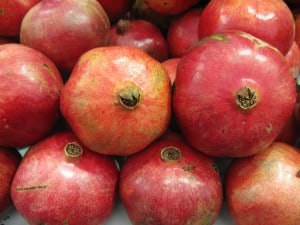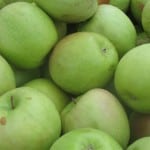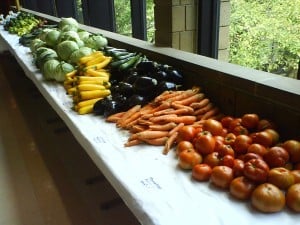What is Rosh Hashanah?
Rosh Hashanah, which literally means the “head of the year”, is the Jewish New Year.
The holiday of Rosh Hashanah is the perfect time to let the blasts of the shofar shake you awake to the world around you. It’s a time to open up to new possibilities and be grateful for everything you have. And more than anything, Rosh Hashanah offers the opportunity for teshuva (returning/repentance) – to return to our best, most full versions of ourselves. As we turn inward, we have the chance to ask, “what impact do our actions have on our friends and family, our communities, and on the earth?”
When is Rosh Hashanah?
In 2022 it will be celebrated from sundown on Sunday, September 25 through sundown on Tuesday, September 27.
In 2023 it will be celebrated from sundown on Friday, September 15 through sundown on Sunday, September 17.
In 2024 it will be celebrated from sundown on Wednesday, October 2 through sundown on Friday, October 4.
In celebration of this time of turning and returning, Hazon created a list of healthy, sustainable resources that will help you welcome Rosh Hashanah with mindfulness, sustainability, and joy.
Activities & Rituals
Go apple picking. What could be better than dipping apples that you picked yourself, straight from the tree? Many family farms welcome visitors to pick apples, make fresh cider, and tour their grounds. Needless to say, this is a great activity for the whole family. Find a farm near you at Pick Your Own.
Eat and Learn. Rabbi Shimon said: If three have eaten at one table and have spoken over it words of Torah, it is as if they had eaten from the table of God, for it is written (Ezekiel 41:22). Ask each of your Rosh Hashanah guests to bring a reading (e.g. traditional Jewish texts, Hasidic tales, a favorite poem or scene from a play, children’s book etc.) to share on a particular Rosh Hashanah-related theme. Need an example? Try “returning,” “scarcity and abundance,” or “mindfulness.” At dinner, ask your guests to share what they brought.
Get outside! Rosh Hashanah celebrations have the tendency to fall into the rhythm of pray, eat, sleep, pray, eat, sleep…eat. This year, change up that rhythm by finding some time to get outside into the crisp fall sunlight. Go for an early morning walk before synagogue, meditate outside in the afternoon, take a walk on the beach (if you’re lucky enough to live by one!), or bring your kids to the park after lunch to sing holiday songs. Whatever way you get there, don’t wait until Tashlich to get outside.
Talk about Tashlich! Use the new year’s ritual of Tashlich to have a conversation about water pollution and what your community can do about it. Learn about your local watershed, and draw connections between casting our spiritual sins into the ocean and throwing our physical trash there. This article by Lauren Deustch, a Los Angeles Waterkeeper, provides an excellent starting point! Tashlich can also be a good opportunity to think about how our homes get clean water. How do we filter the physical bread crumbs out to make water safe to drink again? Tour your local water treatment plant to learn more!
Food & Recipes
Rosh Hashanah Recipes
Apple Kugel
- 2 tablespoons unsalted butter
- 4 apples, cored and cut in small (1/4- to 1/2-inch) dice
- 6 ounces flat egg noodles, preferably whole-grain
- Salt to taste
- ¼ cup raisins, plumped for 5 minutes in warm water and drained (optional)
- 4 eggs
- ¼ cup raw brown sugar or dark brown sugar
- 1 cup drained yogurt
- 1 teaspoon vanilla extract
- 2 tablespoons rum
- ½ teaspoon freshly grated nutmeg
Preheat the oven to 350 degrees. Butter a 2-quart baking dish. Begin heating a large pot of water.
Melt 1 tablespoon of the butter over medium-high heat in a large, heavy skillet and add the apples. Cook, stirring or tossing in the pan, until they begin to color and are slightly tender, about 5 minutes. Remove from the heat.
When the water comes to a boil, add salt to taste and the noodles. Cook al dente, a little firmer than you would want them if you were eating them right away. Drain through a colander and add to the pan with the apples (if using long flat noodles, cut them first with a scissors into shorter lengths). Add the remaining tablespoon of butter and toss together until the butter melts. Stir in the optional raisins. Set aside.
Beat the eggs in a large bowl. Add the sugar and beat together until the mixture is thick. Beat in the yogurt, vanilla, rum, nutmeg and about 1/4 teaspoon salt, or to taste. Add the noodles and apples and fold everything together. Scrape into the prepared baking dish. Push the pasta down into the egg and yogurt mixture (it will not be completely submerged, but try to cover as much as you can). Place in the oven and bake 40 to 45 minutes, until the kugel is set and the sides are browned. There will always be some noodles on top that brown and become quite hard. You can remove these from the baked dish if you wish. Allow to sit for at least 10 minutes before serving. Serve hot, warm or at room temperature.
Recipe originally from NY Times Cooking
Rosh Hashanah Challah
- 1½ tablespoons (1½ packages) active dry yeast
- 1 tablespoon plus ½ cup sugar
- 1¾ cups lukewarm water
- ½ cup vegetable oil
- 3 large eggs
- 1 tablespoon salt
- 8 cups all-purpose flour (about)
- Poppy or sesame seeds for sprinkling
Dissolve the yeast and 1 tablespoon of the sugar in 1¾ cups of lukewarm water in a large bowl
Whisk the oil into the yeast mixture, then beat in two of the eggs, one at a time, along with the remaining sugar and the salt. (You can also use a mixer with a dough hook for both mixing and kneading.) Gradually add 8 cups of flour and stir. When the dough holds together, it is ready for kneading.
Turn the dough onto a floured surface and knead until smooth. Clean out the bowl and grease it, then return the dough to the bowl. Cover with plastic wrap and let the dough rise in a warm place for one hour. (You may also put the dough in an oven that has been warmed to 150 degrees, then turned off.) When the dough has almost doubled in volume, punch it down, cover, and let rise again in a warm place for another half-hour.
To make a six-braided challah, take half the dough and form into six balls. With your hands, roll each ball into a strand tapered at the ends about 12 inches long and 1½ inches wide. Pinch the strands together at one end, then gently spread them apart. Next, move the outside right strand over two strands.
Then, take the second strand from the left and move it to the far right. Regroup to three on each side. Take the outside left strand and move it over two to the middle, then move the second strand from the right over to the far left.
Regroup and start over with the outside right strand. Continue until all the strands are braided, tucking the ends underneath the loaf. The key is always to have three strands on each side, so you can keep your braid balanced. Make a second loaf the same way. Place the braided loaves in greased 10- by 4-inch loaf pans or on a greased cookie sheet with at least 2 inches between them.
Beat the remaining egg and brush it on the loaves. Let rise another half hour.
Preheat the oven to 350 degrees and brush the loaves with egg again, then sprinkle on poppy or sesame seeds.
Bake for 35 to 40 minutes or until golden. Remove the loaves from the pans and cool on a rack.
Recipe originally from The Jew and the Carrot
Caramel Apples
- 8-10 apples (red or green)
- 8-10 Popsicle sticks
- 2 cups of brown sugar
- 400 grams (14 oz) of condensed milk
- 1 large tablespoon of honey
- 200 grams (7 oz) of unsalted butter
- 1 teaspoon of vanilla extract
- Choice of toppings: colored sprinkles, chocolate chips, mini M&M’s, chopped nuts, gummy bears, marshmallows, coconut, chopped biscuits, etc.
Remove stems from apples, then wash and dry the apples.
Insert sticks through the top of the apple, where the stem was. (The stick should go about three-quarters down into the body of the apple).
Combine the sugar, butter, condensed milk, honey and vanilla extract in a 2 1/2 or 3 quart pot, and place it on a small flame.
With a wooden spoon, mix and break down the ingredients so that you end up with a big caramel-brown goo slowly cooking in the pot. Cook until the sugar crystals are dissolved (test by rubbing a little of the caramel between your fingers to feel when it is no longer gritty, but be careful not to burn yourself).
Leave the mixture to cool for 10 minutes.
Once the mixture has cooled, but is still a little warm, hold the stick and immerse the apples into the mixture, fully covering the apple.
Place the coated apples on a plate and put the plate in the fridge for 15 minutes
This last step is especially fun for kids: Place the toppings of choice in small bowls and then insert the apples in the toppings until the toppings reach about a third of the way up the apple.
Return apples to the refrigerator to chill for at least half an hour.
Now all you have to do is place the plate of Rosh Hashanah Caramel Candy Apples on the table and watch people’s reactions. This is a dish that brings out the children in everyone.
Recipe originally from The Jew and the Carrot
Abramson Vegan Breadmaker Challah
This Bread Maker Challah Recipe was graciously submitted By Michelle Harris Abramson.
Makes one large or two small loaves.
Ingredients
- 2 tablespoons dried yeast (two packages)
- ½ cup sugar
- 2 cups luke warm water
- 2 tablespoons ground flaxseed, aka flaxseed meal (NOT whole flaxseeds)*
- 2 tablespoons canola oil
- 4 – 5 cups King Arthur or other good quality bread flour
- ¼ teaspoon xanthan gum (see note)
- 2 teaspoons salt
- Raisins (optional)
Place the yeast, sugar, flax seed meal and water at the bottom of a bread maker and let sit for 5 minutes. Add the rest of the ingredients in the order given. Set the bread maker for dough.
After about 5 minutes, check to make sure that the dough is forming a ball. If it resembles batter, gradually add a bit more flour. If it resembles crumbs, gradually add a bit more water. After one hour, remove dough separate into three ropes, and braid making sure to tuck the ends under.
Note if using raisins: Raisins will be distributed better if you put them in the individual ropes. Just flatten each rope out, line the raisins up, and fold the strand back into a rope.
Let the bread rise again for one half hour on the kitchen counter.
Bake at 350 degrees for 35 – 40 minutes.
The bread is done when tapping the bottom produces a hollow sound.
Michelle recommended Bob’s Red Mill flaxseed meal.
Note: Bob’s Red Mill xanthan gum is available at most grocery stores. It is optional, but we found that adding it results in a moister texture similar to what you might get if you used eggs.
Sustainability Tips
 Celebrate the holiday foods. Pomegranates are an important symbolic food on Rosh Hashanah, but are not necessarily local to most regions in America. Instead of eschewing them entirely from your table, take the moment to recognize why you are including this food and how it fits into your celebration. Ask someone at your dinner table to prepare a few words (a poem or fact sheet) about pomegranates, or whatever other food you’d like to highlight.
Celebrate the holiday foods. Pomegranates are an important symbolic food on Rosh Hashanah, but are not necessarily local to most regions in America. Instead of eschewing them entirely from your table, take the moment to recognize why you are including this food and how it fits into your celebration. Ask someone at your dinner table to prepare a few words (a poem or fact sheet) about pomegranates, or whatever other food you’d like to highlight.
Kosher organic wine. Serve your friends and family wines from Hazon’s kosher, organic wine list. The list got a whole lot longer since Baron Herzog decided to go “sustainable” (three cheers!). The wines on this list are tasty, hechshered and good for the earth – you’ll be able to impress your friends as the world’s best sustainable sommelier.
Highlight local flavors. This year, Rosh Hashanah falls at the beginning of autumn. It is one of the most amazing times to find fresh local vegetables through your CSA or farmers’ market. Serve a root veggie medley that highlights the vegetables of fall. Check out The Jew & The Carrot’s recipe archive for ideas.
Choose good honey. This year, dip your apples in delicious, raw honey produced by a small-scale apiary. Here are some suggestions for companies that provide kosher certified honey that you can trust.
- Bee Raw Honey recommended by The Jew & The Carrot blogger, Eric Schulmiller
- Marshall’s Honey, raw and certified kosher
- Tropical Traditions, raw and certified kosher
- Wee Bee Honey, raw and certified kosher
Seasonal centerpieces. Instead of fresh-cut flowers that will wilt after a few days, create a sustainable centerpiece that will impress your guests. Place 12 heirloom apples or pomegranates in a glass bowl, or place potted fall flowers (chrysanthemums, zinnias, marigolds, etc.) around the table to add seasonal color.
 Cast away cleanup. Tashlich is one of the most beautiful moments of Rosh Hashanah where we head towards a flowing body of water and toss in bread to symbolically cast away our sins. As part of your Rosh Hashanah preparation, take a day in the week leading up to the holiday (and bring your friends and kids) to “clean up” the river or watershed where you will perform the tashlich ritual. Collect any garbage or bottles lying about and walk around to get a lay of the land. When you come back the next week, note if you feel a different connection to the space.
Cast away cleanup. Tashlich is one of the most beautiful moments of Rosh Hashanah where we head towards a flowing body of water and toss in bread to symbolically cast away our sins. As part of your Rosh Hashanah preparation, take a day in the week leading up to the holiday (and bring your friends and kids) to “clean up” the river or watershed where you will perform the tashlich ritual. Collect any garbage or bottles lying about and walk around to get a lay of the land. When you come back the next week, note if you feel a different connection to the space.
Avoid the honey bear. Apples and honey are two of the most recognizable Jewish holiday foods. Meanwhile, the emergence “colony collapse disorder” (aka the mass disappearance of bees from hives) indicates that something is awry in the bee community. Learn about the potential causes of CCD from the Southeast Farm Press. Meanwhile, the ubiquitous honey bear that sits in most of our cabinets tends to be filled with industrially-produced (and not particularly flavorful) honey.
Dig In
Hazon Resources
Food for Thought – A 130-page sourcebook that draws on a range of texts from within and beyond Jewish traditions to explore a range of topics relating to Jews and food.
Hazon Food Guide – The Hazon Food Guide and Food Audit Toolkit will help you navigate food choices in your synagogue or JCC, and offer practical suggestions for bringing our ancient tradition of keeping kosher – literally, eating food that is “fit”– to bear on the range of food choices we’re making today.
Learn more about New York City’s recent bee swarms by reading NYC’s homeless bee swarms are good for bees, from Grist.
Learn more about the disappearance of bees in North America by reading: Bye Bye Bumblebee, from Grist.
Suggestion from Fair Trade Judaica: Serve fair trade certified honey with your apples
My Jewish Learning – Rosh Hashanah 101
Jew and the Carrot articles Relating to Rosh Hashanah:
- Kosher Wines for Your Rosh Hashanah Meals
- Vegan Gift Boxes for Rosh Hashanah
- Gluten Free High Holiday Recipes
- Rosh Hashanah: Honey Advisory
- Turkish Rosh Hashanah Delights
- Preparing the Fields for the New Year
- Drink Your Honey This Rosh Hashanah- Mead and Hard Cider Cocktails





